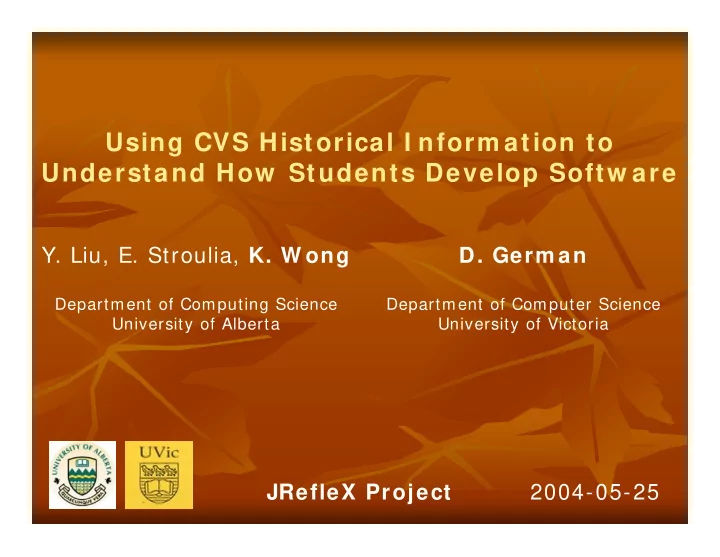

Using CVS Historical I nform ation to Understand How Students Develop Softw are Y. Liu, E. Stroulia, K. W ong D. Germ an Department of Computing Science Department of Computer Science University of Alberta University of Victoria JRefleX Project 2004-05-25
Goals � Enable in-depth understanding of team projects: � team collaboration patterns � individual workload and work pattern � code module evolution trends � Assist instructors/ managers: � monitoring teams � providing relevant/ timely advice 2
Constraints � Tightly integrated with development � not an extra effort, unobtrusive � Current information � “real-time”, as the project is developed � Multi-perspective � include information from revision control, work products, team perceptions, instructor assessments 3
4
Top page Project home pag Edited Wiki page Autogenerated Wiki page of a CVS file 5
Collaboration Analysis � Understanding team collaboration: � What is the “collaboration profile” of each team ? � What works, what doesn’t? � How does each developer contribute? � What files does the developer affect? � With what kinds and numbers of operations? � How does each w ork product evolve? � How does it change? � Which and how many developers affect it? 6
Case Study � Small undergraduate student teams: � 3 to 4 developers each � Development process: � common project, three delivery stages � CVS environment: � records evolving work during process � Novices: � new to using CVS in teams � little project management experience 7
Com paring Across Team s � Questions: � What is the distribution of CVS operations? � How fast do they start? � How long is their development process? � How many idle days? � … 8
Com paring Across Team s � Average numbers of operations of all types, for the teams: D: regular revisions E: only finished products 9
Com paring Across Team s � Total numbers of operations over time, for all teams: deadlines D: continuous early work 10
Mem bers w ithin Team � Questions: � Who contributes? � In what role(s)? � stub writer, tester, debugger � … 11
Mem bers w ithin Team D � Total numbers of operations over time, for members of team D: work by member 2 12
Mem bers w ithin Team D � Numbers of operations of all types, for members of team D: work by member 2 (team lead?) few collisions 13
Mem bers w ithin Team E � Total numbers of operations over time, for members of team E: long idle periods 14
Mem bers w ithin Team E � Numbers of operations of all types, for members of team E: work by member 3? independent? 15
Files of a Team � Questions: � How many source files does a team have? � Which files are changed by multiple members? � Which files are heavily changed? � Which files are central? � Who is the likely author of a file? � What is the distribution of operations? 16
Files of Team D � Resulting lines of code in files: abnormally high number of files? 17
Files of Team E � Resulting lines of code in files: 18
Files of Team E � Added and deleted lines to files: 19
Assessm ents � Issue: � information implicitly inferred from CVS data is revealing, but needs to be validated � it is interesting to compare it with data explicitly provided by developers and managers � these questionnaires are required for the students to complete 20
Team D � Compliments: � “because of my group members work ethics in being determined to start early, w ork regularly , and keeping each other updated on one another’s progress” � “ com m unication w as open and constant via ICQ and email” � “each member was more than willing, if not enthusiastic, to contribute and participate” � “I was very impressed with other members’ willingness to help other members with problems in their ‘assigned’ areas” � “ student 2 did a lot of w ork with the coding (especially the interface design” � “ very im pressed with the effort that student 2 and 21 student 1 put into the GUI”
Team E � Complaints (stage 2) � “some confusion as to w ho w as doing w hat . Some parts were done out of order so we couldn’t do our part until all this other stuff was built” � “some m iscom m unication of what the plan was” � “concentrated largely on the front-end and the back- end was poorly form ed and probably will have to be redone for the next part of the project” � Complaints (stage 3) � “ reverted to the old w ays of the computer geek” � “it is better to underestimate yourself than to overestimate” 22
Vision � Ongoing work: � complete, integrated data collection (e.g., include PSP measures, code metrics, defects, communication) � complementary set of “diff” algorithms (e.g., compare versions, identify refactorings and co-evolution) � allow teams to reflect on their own progress and process (process mentor) � improved visualization 23
Vision � Ongoing work: � data-mining � try to find some associated operation and set reminders � identify developers according to roles � in-class experiments � we are looking for partners! � { kenw , s t r ou l i a }@cs. ua lbe r t a . ca � h t tp : / / www.cs .ua lbe r ta . ca/ ~s t rou l i a / j r e f l ex / 24
Discussion � Issues: � granularity � operations versus MRs � interpretation � knowledge of underlying process � generalizing � open source? scalability? � conducting studies � ethical approval, anonymizing data, privacy � benchmark data sets 25
Recommend
More recommend